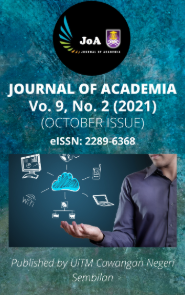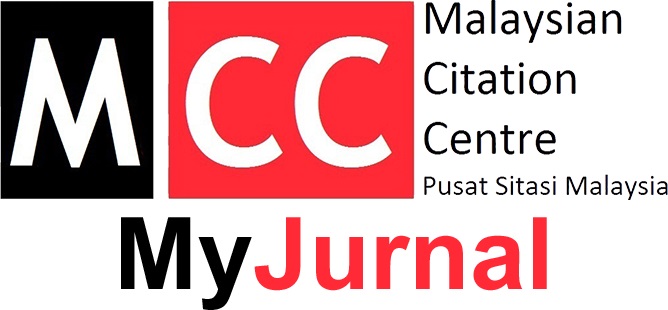SPECIES DIVERSITY OF DRAGONFLY (ARTHROPODA: ODONATA) AND ITS RELATIONSHIP WITH AIR PARAMETERS AT SG. MUAR, KUALA PILAH
Keywords:
air parameters, diversity, distribution, dragonfly, Sg. MuarAbstract
The study of diversity and distribution of dragonfly, and their relationship with air parameters
(temperature (°C) and humidity (%)) at Sg. Muar, Kuala Pilah, Negeri Sembilan was carried out on 14
and 15 March 2020. The sampling of dragonfly was done in two parts of Sg. Muar, Kuala Pilah. For
each site, the sampling was conducted in the morning (8-9 a.m) and evening (6-7 p.m) with the air
temperature and humidity were recorded at the same time using the hygrometer and digital thermometer
clock humidity temperature HTC-1. Sample collections are carried out by sweeping the samples using
sweep net. The samples were collected, preserved and identified until species level. A total of 231
individuals were recorded with Ischnura elegans from Coenagrionidae family as a dominant species
with 145 individuals (63%), while the lowest abundance is Pseudagrionidae sp. of Coenagrionidae
family with one individual (0.004%) only. Meanwhile, there is no significant relationship (p<0.05)
between air parameters with individual number of dragonflies. As a recommendation, other parameters
of air and water should be measured to increase our understanding on its effects towards the
survivability of dragonfly. This research gives benefit to society and ecology, where it can be used as
guidelines for future research, update the checklist of dragonfly and conservation purpose in Sg. Muar,
Kuala Pilah.
References
Acquah, D., Kyerematen, R., & Owusu, E. O. (2013). Using odonates as markers of the environmental health of
water and its land related ecotone. International Journal of Biodiversity and Conservation, 5(11), 761-769. DOI:
5897/IJBC2013.0600
Adu, B. W., Kehinde, Kemabonta, K.A., & Ogbogu, S. S. (2016). Monitoring of environmental disturbance using
abundance and distribution of red-vein and dark-vein species of genus Trithemis (Odonata: Libellulidae). The
Zoologist, 14, 31-36.
Western
Al-Digail, S. A., Assagaf, A. I., & Mahyoub, J. (2012). Effect of temperature and humidity on the population
abundance of Spotted Oriental Cucumber Beetle Epilachna chrysomelina (F.) (Coccinellidae: Coleoptera) In Al-
Qunfudah
Saudi
Arabia. Current
http://dx.doi.org/10.12944/CWE.7.1.02
World
Environment,
(1),
-12.
DOI:
Ameilia, Z. S., Che Salmah, M. R. & Abu H. A. (2006). Diversity and distribution of dragonfly (Odonata: Insecta)
in the Kerian River Basin, Kedah- Perak, Malaysia. University of Sains Malaysia. USU Repository. pp. 14.
Borror, D. J., & White, R. E. (1970). A field guide to the insects of America north of Mexico. Boston: Houghton
Mifflin Company.
Brasil, L. S., Luiza-Andrade, A., Calvão, L. B., Dias-Silva, K., Faria, A. P., Shimano, Y., Oliveira-Junior, J. M.,
Cardoso, M. N., & Juen, L. (2020). Aquatic insects and their environmental predictors: A scientometric study
focused on environmental monitoring in lotic environmental. Environmental Monitoring and Assessment, 192,
DOI: https://doi.org/10.1007/s10661-020-8147-z
Cai, Y., & Ngiam, R. (2018). Diversity, distribution and habitat characteristics of dragonflies in Nee Soon
freshwater swamp forest, Singapore. The Gardens' Bulletin, Singapore, 70(Suppl. 1), 123-153. DOI:
26492/gbs70(suppl.1).2018-07
Choong, C. Y., Alwen, B. M., & Tan, C. C. (2018). Odonata of Sungai Dusun Wildlife Reserve, Selangor,
Peninsular Malaysia. Journal of Wildlife and Parks, 33, In press.
Clausnitzer, V. (1998). Territorial behaviour of a rainforest dragonfly Notiothemis robertsi (Odonata:
Libellulidae): proposed functions of specific behavioural patterns. Journal of Zoology, 245(2), 121-127. DOI:
https://doi.org/10.1111/j.1469-7998.1998.tb00081.x
Corbet (1999). Dragonflies: Behaviour and ecology of Odonata. Aquatic Insect, 23(1), 83. DOI:
https://doi.org/10.1076/aqin.23.1.83.4929
Corbet, P. S. (2013). Odonata. Encyclopedia Britannica. https://www.britannica.com/animal/Odonata [Access
online 2 Mac 2020]
Dow, R. A., & Reels, G. T. (2015). Odonata collected at Usun Apau National Park, Miri Division, Sarawak,
Malaysia in April and May 2012. Journal of the International Dragonfly Fund, 79, 1-17.
Futahashi, R. (2016). Color vision and color formation in dragonflies. Current opinion in insect science, 17, 32
DOI: 10.1016/j.cois.2016.05.014
Ganti, A. Journal of Academia Vol. 9, Issue 2 (2021) 30 – 39 definition. (2020). Correlation coefficient https://www.investopedia.com/terms/c/correlationcoefficient.asp. [Access online 29 June 2020].
Haeck, I. M., Berge, O. T., van Velsen, S. G. A., de Bruin-Weller, M. S., Bruijnzeel-Koomen, C. A. F. M., &
Knol, M. J. (2012). Moderate correlation between quality of life and disease activity in adult patients with atopic
dermatitis. Journal of the European Academy of Dermatology and Venereology, 26, 236–241. DOI:
1111/j.1468-3083.2011.04043.x
Hammers, M., Sánchez-Guillén, R. A., & Gossum, H. V. (2009). Differences in mating propensity between
immature female color morphs in the Damselfly Ischnura elegans (Insecta: Odonata). Journal of Insect Behavior,
, 324-337. DOI: https://doi.org/10.1007/s10905-009-9175-2
Hammers, Ø., Harper, D. A. T., Ryan, P. D. (2001). PAST 3.22: Paleontological statistic software package for
education and data analysis. Palaeontologia Electronica 4(1), 9.
Javaid, A. S., & Ashok, K. P. (2013). Application of diversity indices to crustacean community of Wular Lake,
Kashmir Himalaya. International Journal of Biodiversity and Conservation, 5(6), 311-316.
Kalkman, V. J., Clausnitzer, V., Dijkstra, K. B., Orr, A. G., Paulson, D. R., & Tol, J. V. (2007). Global diversity
of dragonflies (Odonata) in freshwater. Hydrobiologia, 595(1), 351-363. DOI: 10.1007/978-1-4020-8259-7_38
Koneri, R., Nngoy, M. J., Saroya, & Tallei, T. (2017). Diversity and community composition of dragonfly
(Insecta: Odonata) in Tangkoko, Nature Reserve, North Sulawesi, Indonesia. Bioscience Research, 14(1), 01-08.
Korkeamäki, E., & Suhonen, J. (2002). Distribution and habitat specialization of species affect local extinction in
dragonfly Odonata populations. Ecography, 25, 459–465. DOI: https://doi.org/10.1034/j.1600
2002.250408.x
Kumar, D. B., Uddipta, S., & Phalgun, C. (2015). Diversity, distribution and abundance of Damselfly (Zygoptera)
of Kapla Beel, Wetland of Barpeta District; Assam, India. International Research Journal of Biological Sciences,
(4), 69-76. DOI: http://www.isca.in/IJBS/Archive/v4/i4
Kvålseth, T. O. (2015). Evenness indices once again: critical analysis of properties. SpringerPlus, 4, 232. DOI
1186/s40064-015-0944-4
Luke, S. H., Dow, R. A., Butler, S., Khen, C. V., Aldridge, D. C., Foster, W. A., & Turner, E. C. (2017). The
impacts of habitat disturbance on adult and larval dragonflies (Odonata) in rainforest streams in Sabah, Malaysian
Borneo. Freshwater Biology, 62(3), 491-506. DOI: https://doi.org/10.1111/fwb.12880
Manwar, N. A., Shivaji, S. C., Rathod, P. P., & Raja, I. R. (2012). Diversity and abundance of dragonflies and
damselflies (Order - Odonata) of Pohara Range in Pohara - Malkhed Reserve Forest, Maharashtra (India).
Zoology, 3(6), 208-210. DOI: 10.15373/22501991/June2014/67
Marsh, G. A., & Fairbridge, R. W. (1999). Lentic and lotic ecosystems. Encyclopedia of Earth Science
Environmental Geology, 381-388.
Neog, N., & Rajkhowa, S. (2016). Dragonfly diversity in two different ecosystems in and around Assam
University, Silchar (Ecoforest and Irongmara). Journal of entomology and zoology studies, 4(4), 184-190.
Norma-Rashid, Y., Mohd-Sofian, A., & Zakaria-Ismail, M. (2001). Diversity and distribution of Odonata
(dragonflies and damselflies) in the freshwater swamp lake Tasek Bera, Malaysia. Hydrobiologia, 459, 135-146.
DOI: https://doi.org/10.1023/A:1012562611307
Orr, A. G. (2013). The importance of dragonflies as food for breeding Raincbowbirds in subtropical eastern
Australia. Agrion, 17, 38-43.
Orr, A. G. (2005). Dragonflies of Peninsular Malaysia and Singapore. Kota Kinabalu, Sabah: Natural History
Publications (Borneo).: pp. 125.
Orr, A. G. (2004). Critical species of Odonata in Malaysia, Indonesia, Singapore and Brunei. International
Journal of Odonatology, 7(2), 371 - 384. DOI: 10.1080/13887890.2004.9748222
Orr, A. G., & Hämäläinen, M. (2003). A guide to the dragonflies of Borneo: thier identification and biology.
Natural History Publications (Borneo) Sdn. Bhd., Kota Kinabalu.: pp. 195
Pires, M. M., Kotzian, C. B., Spies, M. R., & Neri, D. B. (2013). Diversity of Odonata (Insecta) larvae in streams
and farm ponds of a montane region in Southern Brazil. Biota Neotropica, 13(3), 259-267. DOI:
https://doi.org/10.1590/S1676-06032013000300028
Suhonen, J., Hilli-Lukkarinen, M., Korkeamaki, E., Kuitunen, M., Kullas, J., Pettinen, J., & Salmela, J. (2002).
Local Extinction of Dragonfly and Damselfly Populations in Low- and High-Quality Habitat Patches.
Conservation Biology, 24(4), 1148-53.
Sheldon, F., & Walker, K. F. (1998). Spatial distribution of littoral invertebrates in the lower Murray–Darling
river system, Australia. Marine Freshwater Research, 49, 171-182. DOI: 10.1071/MF96062
Tennessen, K. (2009). Odonata. Encyclopedia of Insects, Elsevier Inc. New York.: pp. 721-729. DOI:
https://doi.org/10.1016/B978-0-12-374144-8.00194-6
Trottier, R. (1973). Influence of temperature and humidity on the emergence behaviour of Anax Junius (Odonata:
Aeshnidae). The Canadian Entomologist, 105(7), 975-984. DOI: https://doi.org/10.4039/Ent105975-7
Wahizatul-Afzan, A., Juliá, J., & Amirrudin, A. (2006). Diversity and distribution of dragonflies (insecta:
odonata) in Sekayu recreational forest, Terengganu. Journal of Sustainability Science and Management, 1(2), 97
Yen, C. C., Arifin, Y. M., & Hijas, N. H. (2018). Ancient creatures: dragonflies and damselflies of Malaysia.
Putrajaya, Selangor: Ministry of Water, Land and Natural Resources, Putrajaya.: pp. 115
Downloads
Published
Issue
Section
License
Copyright (c) 2021 Journal of Academia

This work is licensed under a Creative Commons Attribution-NonCommercial-NoDerivatives 4.0 International License.












